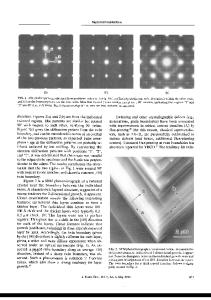Growth and characterization of (Bi, Pb) 2 Sr 2 Ca 2 Cu 3 O x single crystals
- PDF / 356,905 Bytes
- 7 Pages / 612 x 792 pts (letter) Page_size
- 11 Downloads / 392 Views
MATERIALS RESEARCH
Welcome
Comments
Help
Growth and characterization of (Bi, Pb)2 Sr2 Ca2 Cu3 Ox single crystals Shaoyan Chu and Michael E. McHenry Department of Materials Science and Engineering, Carnegie Mellon University, Pittsburgh, Pennsylvania 15213 (Received 19 November 1996; accepted 20 May 1997)
(Bi, Pb)2 Sr2 Ca2 Cu3 Ox (2223) single crystals have been grown using a fused-salt reaction of Bi2 O3 , PbO, SrCl2 , CaCl2 , CuCl, and KNO3 in a KCl flux. The pristine crystals show regular plate-like morphology with typical dimension of 0.1 3 0.1 3 0.001–0.01 mm3 . Crystal orientation, chemical composition, phase purity, and superconductivity of the pristine crystals were determined by SEM, TEM, EDX, x-ray diffraction techniques, and SQUID magnetometry. The relative fraction of the Bi-2223 phase (Tc 110 K) in as-grown crystals is ,97%. The only impurity phase, Bi-2212, occurs in some selected crystals but is present in amounts less than the detection limit of x-ray diffraction and is unobserved in the diamagnetic signal determined by SQUID magnetometry.
I. INTRODUCTION
Since the discovery of high-Tc superconductivity in the Bi–Sr–Ca–Cu–O class of cuprate materials, much effort has been devoted to grow high quality BSCCO single crystals. The BSCCO system consists of three important superconducting phases, i.e., Bi-2201, Bi2212, and Bi-2223 with transition temperatures of 20, ,80, and 110 K, respectively. Intergrowth of multiple phases in a crystal grain has posed difficulties in preparing single phase crystals. Several techniques, including self-flux,1 floating zone,2 alkali-halide flux,1,3 alkali-carbonate flux,4 whisker method,5,6 and CAP treatment,7,8 have been used to grow BSCCO single crystals. The size and quality of Bi-2201 and Bi-2212 crystals are good enough for certain experimental observation. Measurements of resistive transition temperatures and magnetization reveal a high-Tc superconducting transition at ,110 K in some crystals, but structure analysis9 does not indicate that Bi-2223 is the majority phase in these as-grown crystals. CAP treatment has been proposed as an idea for converting the Bi-2212 phase to the Bi-2223; however, it has not been demonstrated that single phase Bi-2223 crystals can be reduced by this technique.7 Bi-2223 single crystals, to our present knowledge, are still not available, in spite of their great importance in determining fundamental properties of this phase, and unraveling the growth mechanism of this phase which is so important in synthesizing HTSC wire and tape and electrical devices. For lack of large single crystals, studies of 2D fluctuations10–12 and the pinning properties of the Bi-2223 phase in the absence of grain boundaries have been largely unexplored. Many studies that have depended on measurements of polycrystalline specimens with small grain sizes can be questioned because of J. Mater. Res., Vol. 13, No. 3, Mar 1998
http://journals.cambridge.org
Downloaded: 17 Mar 2015
significant boundary effects on sample properties. This has motivated us to gr
Data Loading...











